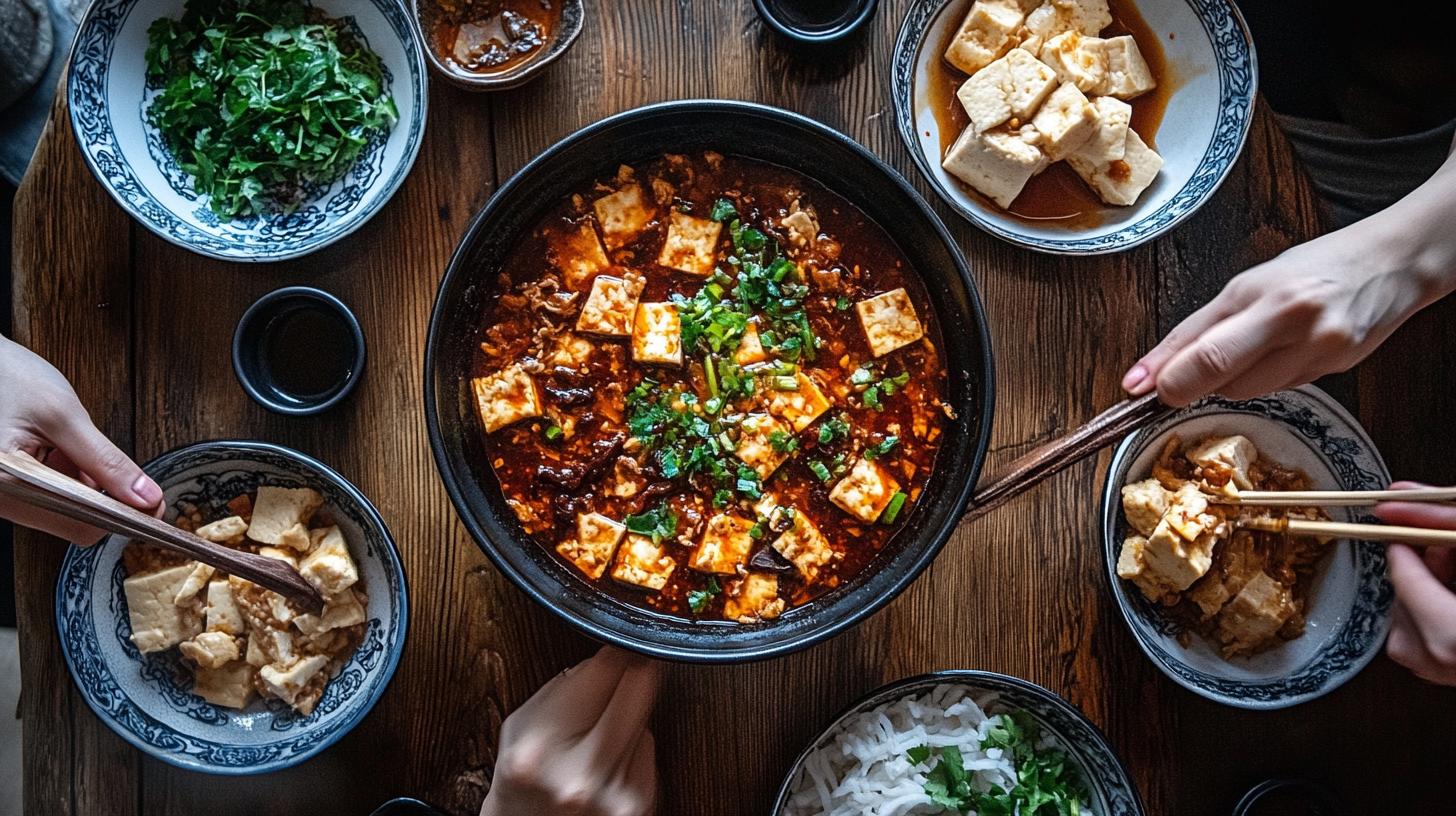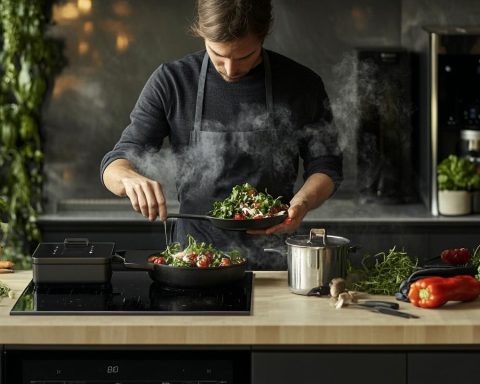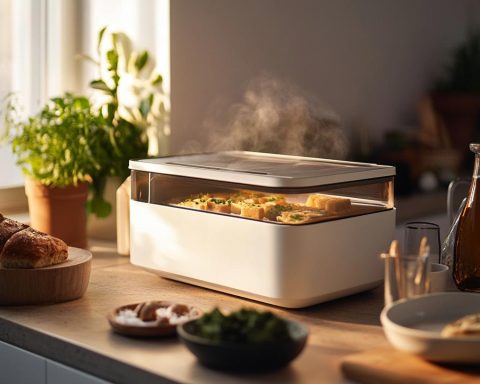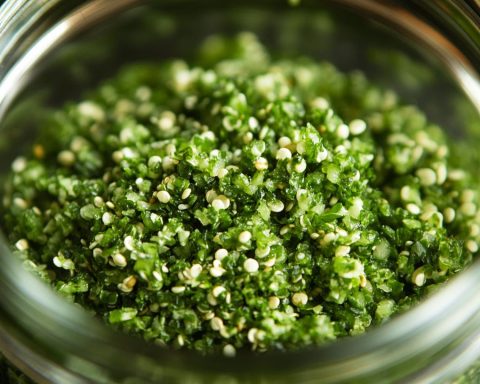Mapo Tofu, a renowned dish from the heart of China’s Sichuan province, offers a mesmerizing dance of flavors; it’s where fiery heat meets comforting silkiness, all under the aromatic embrace of Sichuan peppercorns. This dish’s origins can be traced back to the city of Chengdu, where a resourceful chef named Mrs. Chen invented it over a century ago. Her husband was left with facial pockmarks from a bout of smallpox, leading to the name “Mapo,” which means “pockmarked old woman” in Chinese. Despite the unassuming name, Mapo Tofu has grown to become a staple not only in Chinese homes but also in many corners of the world, cherished for its bold flavors and textural harmony.
Ideal for adding a spicy kick to your dinner table, Mapo Tofu boasts a delectable balance of soft tofu cubes glazed in a spicy, savory sauce enriched with fermented black beans and minced meat, often pork or beef. This hearty dish can vary in calories, commonly ranging from 300 to 500 per serving, depending on your choice of protein and oil. Whether for a cozy family meal or an adventurous dining experience, Mapo Tofu promises to be a flavorful centerpiece that leaves guests yearning for more.
Ingredients:
- 1 block (14 oz) silken or medium-firm tofu, drained and cut into 1-inch cubes
- 3 tablespoons vegetable oil
- 3 tablespoons Sichuan peppercorns
- 1/2 pound ground pork or beef
- 2 tablespoons doubanjiang (spicy Sichuan bean paste)
- 1 tablespoon douchi (fermented black beans), rinsed and minced
- 1 tablespoon ginger, finely minced
- 2 cloves garlic, finely minced
- 1 cup chicken or vegetable broth
- 2 teaspoons soy sauce
- 1 teaspoon sugar
- 1 teaspoon cornstarch mixed with 2 teaspoons water
- 2 scallions, finely chopped
- Steamed rice, for serving
Instructions:
1. Prepare the Tofu
Start by draining the tofu and cutting it into 1-inch cubes. For best results, gently simmer the tofu in salted water for 3-5 minutes, then carefully remove and set aside. This will enhance the texture and help the tofu absorb more flavor.
2. Toast the Sichuan Peppercorns
Heat a large wok or non-stick skillet over medium heat. Add the Sichuan peppercorns and dry-toast them until fragrant, taking care not to burn them. Set aside to cool slightly, then grind to a fine powder using a mortar and pestle or spice grinder.
3. Cook the Meat
In the same wok, add the vegetable oil and increase the heat to medium-high. Add the ground pork or beef, breaking it up with a spatula as it cooks. Stir-fry until browned and cooked through.
4. Create the Aromatic Base
Reduce the heat to medium, and stir in the doubanjiang, douchi, minced ginger, and garlic. Stir-fry until the mixture is fragrant, about 1-2 minutes.
5. Assemble the Sauce
Pour in the chicken or vegetable broth, soy sauce, and sugar. Bring the mixture to a simmer, then carefully add the tofu cubes, ensuring they are submerged in the sauce. Simmer for 5 minutes to allow the flavors to meld with the tofu.
6. Thicken and Finish
Stir in the cornstarch slurry, and gently stir the tofu to thicken the sauce to your desired consistency. Add the ground Sichuan peppercorns and adjust the seasoning if needed.
7. Serve and Enjoy
Garnish with finely chopped scallions and serve hot with steamed rice.
Cooking Tips:
– Tofu Texture: Silken tofu offers a creamy texture, but if you prefer something firmer for stir-frying, opt for medium-firm tofu.
– Spice Level: Adjust the amount of doubanjiang and Sichuan peppercorns to moderate the heat according to your palate.
Serving Suggestions:
Pair Mapo Tofu with a crisp, aromatic white wine such as Riesling, or try a light, refreshing beer to counterbalance its spicy, peppery notes. Enhancing your meal with a side of crisp, blanched greens drizzled with sesame oil creates a harmonious contrast with the intense flavors of the dish. Prepare to savor a symphony of sensations that Mapo Tofu so vividly orchestrates.
Elevate Your Culinary Game with These Mapo Tofu Tips and Tricks
Ingredient Substitutions:
If you’re missing some traditional ingredients, don’t fret. Consider these substitutions to maintain the flavor integrity of Mapo Tofu:
– Doubanjiang Substitute: If you can’t find doubanjiang, you can use a combination of red chili flakes and a splash of soy sauce to mimic its spicy and umami profile.
– Douchi Alternative: Olives or capers can work as a substitute, providing the salty, fermented flavor that douchi brings.
– Sichuan Peppercorns Replacement: While the tingling sensation of Sichuan peppercorns is unmatched, black pepper combined with dried lime zest can serve as an emergency stand-in.
Cooking Techniques:
To ensure the most authentic Mapo Tofu flavor:
– Tofu Prep: For a stronger texture, freeze the tofu overnight, then thaw and drain it before cooking. This process alters the soy protein network, giving a meatier bite.
– Broth Enrichment: Replace half of the broth with mushroom broth to amplify the earthy flavors and add depth to the dish.
Common Mistakes to Avoid:
– Overcooking Tofu: Tofu should retain its shape and soft texture, so avoid stirring too vigorously once added to the sauce.
– Burning the Aromatics: The key to a rich Mapo Tofu is gently cooking the garlic, ginger, and doubanjiang until aromatic. High heat can lead to bitter flavors, which should be avoided.
Regional Variations:
Mapo Tofu is a highly adaptable dish with variations across different locales:
– Cantonese Style: Tends to be milder, often substituting pork with seafood such as shrimp or scallops for a delicately sweet twist.
– Japanese Version (Mabo Dofu): Includes a sweeter sauce and the addition of miso paste to balance the dish’s acidity and heat.
Health Benefits:
Mapo Tofu is not just a treat for your taste buds; it offers noteworthy health advantages:
– Rich in Protein: Tofu and minced meat provide a substantial protein source, supporting muscle health and repair.
– Antioxidant-Rich: The capsaicin in chili peppers and the natural compounds in ginger contribute to antioxidant intake, benefiting overall health.
Storage Tips:
– Refrigeration: Store leftovers in an airtight container for up to three days in the refrigerator. Reheat gently on the stove to maintain consistency and prevent separation.
– Freezing: Although tofu can be temperamental when frozen, if you do freeze the dish, ensure it’s reheated slowly to revive its original texture.
For more insights into Sichuan cuisine and to explore a diverse range of Chinese recipes, visit Sichuan Cuisine.








